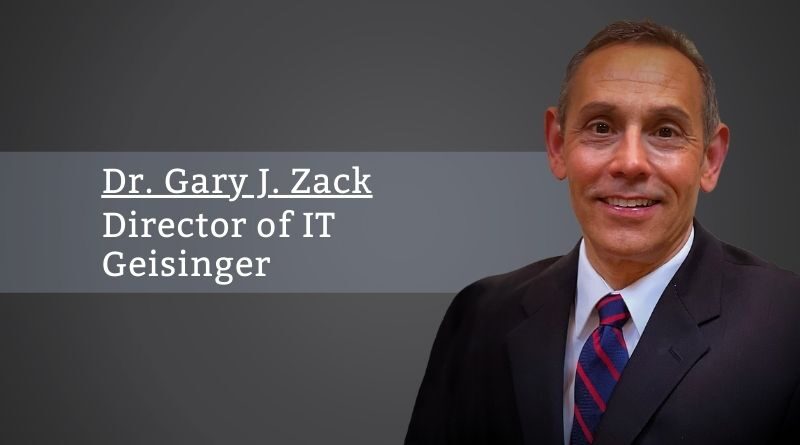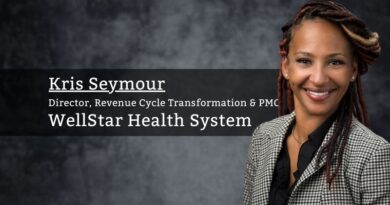The Role of Emerging Technologies in Healthcare
By Dr. Gary J. Zack, DBA, MS, BSChE, Director of IT, Geisinger
We are witnessing some of the most remarkable technology advances across all industry facets ever. The rapid aggregation, analysis, and visualization of data from multiple sources are becoming a way of everyday business and personal life. Imagine if we were still using typewriters, whiteout, and correction tape while writing a report and making multiple telephone calls to gather and verify data to reach a decision consensus. It does not seem easy to imagine life without a smartphone and how we communicate digitally today using email, text messaging, and social platforms such as Facebook.
Digital transformation and modernization continue to be hot topics as part of emerging technology. Still, most leaders do not understand the full scope of the effort to implement such technology and the potential benefits for users. To be clear, implementing emerging technology is not just about hardware, infrastructure, system customization, physical asset digitalization, algorithms, automation, data collection, accessibility, analysis, and augmenting traditional management processes. Applying emerging technology is about establishing a deliberate and persistent technology strategy that repositions the organization’s business to provide better services and products. The approach involves a comprehensive and intentional objective that includes close communication, innovative education, and core training among multiple disciplines and stakeholders.
The array of emerging technology is large, and the most prominent are practically household names. The list of commonly known emerging technologies include
a) Internet,
b) Cloud computing,
c) Blockchain,
d) Robotic process automation (RPA),
e) Internet of things (IoT),
f) Artificial intelligence (AI),
g) Machine learning (ML),
h) Deep learning,
i) Natural language processing (NLP) and
j) Big data
are critical elements of the emerging technology landscape that impact daily business and life activities. Currently, the application of emerging technology is somewhat random since best practices are not yet clearly defined. Empirical evidence and practical use of such technologies illustrate efficiency improvements regarding work activities from a delivery, quality, and cost perspective. The fit-for-use concept is to create a ubiquitous system that homogeneously integrates physical objects and virtual assets digitally that can manipulate business operations based on data analysis for real-time and proactive decision-making.
Healthcare organization leaders know that there is something better out there to improve their business and understand that emerging technologies can play a significant role in the evolution of healthcare to improve care delivery systems and quality while reducing cost and enhancing revenue. However, knowing that improvement solutions are on the horizon does not mean leaders give directives to implement a solution without buy-in from all stakeholders. Motivation factors that have a universal impact must be a consideration. Healthcare providers moving away from homegrown health information processes and towards e-healthcare is a common factor. Other factors may include dissatisfaction with EHR usability, electronic claim processing, payment variances, remittances, and organization size. Each factor solution requires digital modernization of information communication systems.
Common management challenges of implementing emerging technology are not having the highest level of constant executive leadership support, attention, and funding.
Additionally, advancements in e-health solutions are possible using emerging technologies such as AI to uncover insights for treatment opportunities that are faster, cheaper, and cover a wide range of patients. The role of AI algorithms in combination with IoT devices is becoming more pervasive than smartphones to collect data digitally and convert data into valuable results. Using mobile IoT sensors, sensor data can enable health monitoring and remote diagnostics for rapid application. For instance, people can have several personal sensors which AI data analytics trigger a health care decision such as further treatment or examination. Other applications include self-sovereign identity verification for health record sharing, medical implant monitoring, and health plan payments using a digital wallet. The list of health care possibilities is long, and any item can become a reality through empirical studies.
Just like flipping a switch to turn lights on in a room, the same holds for organization managers using emerging technologies such as AI, ML, and blockchain to discover future trends continuously with real-time supporting data to treat disease cognitively. For instance, telesurgery using robotic surgical devices without being physically present can expand specialty procedures while reducing cost and surgical inequities of healthcare for individuals living in remote locations. However, implementing emerging technologies involves developing a comprehensive strategy that includes organization and process revision, training, converting historical data, and clinical leadership involvement to sort through the chaos of managing redesign and change.
Implementing emerging technology is disruptive and costly. Common management challenges of implementing emerging technology are not having the highest level of constant executive leadership support, attention, and funding. The technical challenge is selecting the right combination of protocols to connect disparate systems for orchestrating digital workflows while maintaining flat headcounts and costs. Security, privacy, and safety are threat challenges that require mitigation strategies to reduce risk. The most critical barrier is not technical but is a cultural transformation that must treat as such for adoption and support.
Establishing an emerging technology taxonomy is necessary to control access to evidence-based tools that function persistently to collect and analyze data for the best patient care. The plan must include continuous technology learning and research, a current state technology analysis, specifications for the new infrastructure based on the current state, and an iterative implementation phase approach that involves testing before production. There are several emerging technology solutions, and any final resolution to launch must rely on peripheral technology developments to satisfy the expectations of all stakeholders, including the product recipients. Modernizing and testing the backend is the first step before setting up the user front end, which demands single ease of use dashboard. Developing and tracking measurable success indicators on the front-end, including satisfaction scores from employees, clinicians, and patients, are just as important as noting financial benefits.
Although there are apparent successful roles for emerging technology, we must be aware of limitations and rely on results rather than what is working for an institution somewhere else. Emerging technology is immature and is not perfect. However, the development and use of emerging technologies create innovative platform opportunities that shape the market and not vice versa. New technology does not randomly appear but results from purposeful efforts that transform the market through new product offerings, service, price, new customers, supply chain network expansion, and unknown non-traditional solutions that change industry standards. While applying emerging technology improves an organization’s technology, it is an opportunity for organizational change preparation regarding the alignment of people, processes, and technology to provide the best health equity.



